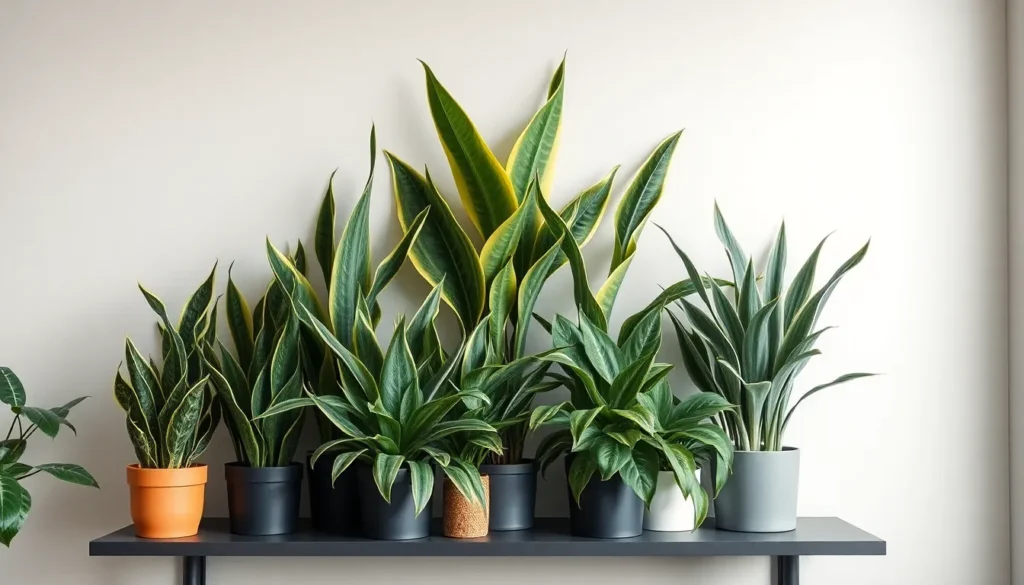Snake plants have become the ultimate houseplant heroes for modern homes and offices. We’ve watched these stunning succulents transform spaces with their architectural beauty while demanding almost zero maintenance from busy plant parents.
What makes snake plants truly remarkable isn’t just their ability to thrive in low light or survive weeks without water. It’s the incredible variety of shapes, sizes, and colors they offer. From the towering Sansevieria trifasciata with its sword-like leaves to the compact bird’s nest varieties perfect for desktops, there’s a snake plant that’ll perfectly complement your space and lifestyle.
We’re about to explore the most popular and unique snake plant varieties that’ll help you choose the perfect green companion. Whether you’re looking for a dramatic floor plant or a charming tabletop accent, these resilient beauties will deliver style and air-purifying benefits without the stress of complicated care routines.
Sansevieria Trifasciata (Mother-in-Law’s Tongue)
Sansevieria trifasciata stands as the most recognizable snake plant variety worldwide. We find this classic species in countless homes and offices because of its distinctive upright leaves and incredible resilience.
Golden Edge Variety
Golden edge snake plants feature bright yellow margins that create stunning visual contrast against dark green centers. We love how these plants brighten any corner with their vibrant golden borders that run along each leaf’s perimeter. Light conditions don’t affect the golden coloring as much as other variegated plants, making them perfect for indoor spaces with limited natural light. Growth patterns remain compact and manageable, typically reaching 2-3 feet in height when fully mature. Care requirements mirror standard snake plants, needing water only when soil feels completely dry to the touch.
Silver Hahnii Dwarf Version
Silver Hahnii varieties grow in distinctive rosette patterns that never exceed 8 inches in height. We recommend these compact plants for small spaces like desks, bookshelves, or bathroom counters where larger snake plants won’t fit. Thick, silver-green leaves form tight clusters that spread outward rather than growing tall like their full-sized relatives. Watering needs decrease significantly due to their smaller size, requiring moisture only every 3-4 weeks during growing season. Propagation happens easily through leaf division, allowing us to create multiple plants from one original specimen.
Laurentii Yellow-Bordered Classic
Laurentii snake plants showcase the most popular color combination with deep green centers and creamy yellow edges. We consider this variety the gold standard for snake plant enthusiasts because it perfectly balances visual appeal with low maintenance requirements. Vertical growth reaches impressive heights of 4-6 feet when given adequate space and proper care conditions. Yellow borders maintain their vibrant appearance even in low light environments where many other variegated plants lose their coloring. Durability makes these plants excellent choices for beginners who want attractive foliage without complicated care routines.
Sansevieria Cylindrica (African Spear Plant)
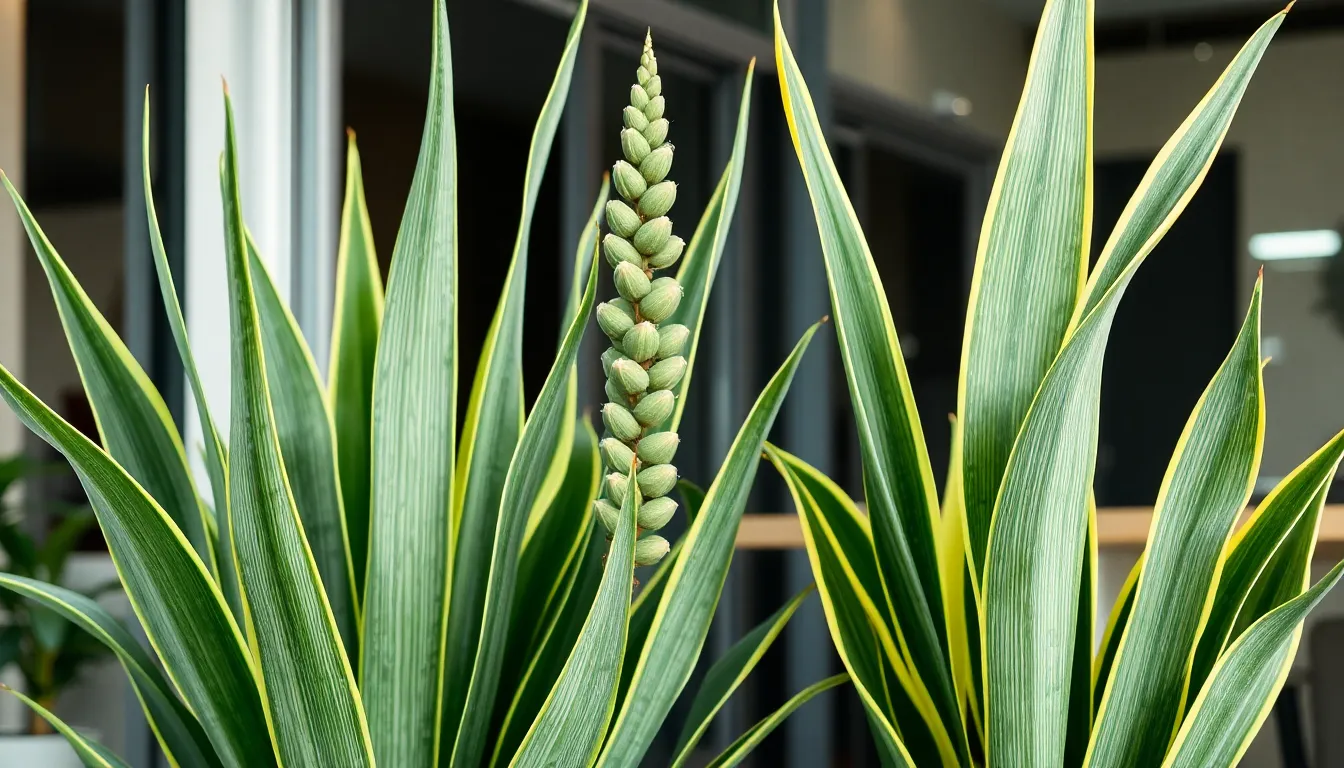
Architectural beauty meets minimal maintenance in the Sansevieria cylindrica, a striking snake plant that stands out with its unique spear-like form. We’ve found this African native particularly appealing for modern spaces where dramatic vertical lines create visual impact.
Straight Cylindrical Growth Pattern
Straight vertical leaves distinguish this variety from traditional flat-leaved snake plants, creating an impressive architectural display. Each cylindrical leaf grows 1.4 to 1.5 inches thick and reaches mature heights of 4 to 7 feet, forming striking spear-like columns. Gray-green coloring with subtle striping patterns adds sophisticated visual texture without overwhelming nearby decor elements.
Basal rosette growth patterns allow multiple cylindrical leaves to emerge from a central base, creating natural groupings that enhance the plant’s dramatic presence. Stiff, pointed tips maintain perfect vertical alignment, making this variety ideal for corners and spaces where you want to draw the eye upward. Low light tolerance means these plants maintain their impressive form even in challenging indoor conditions.
Braided Decorative Arrangements
Braided formations transform young cylindrical leaves into stunning decorative centerpieces through careful manipulation during the growing process. We’ve observed that this purely aesthetic technique involves weaving several flexible young leaves together while they’re still pliable. Three to five leaves typically create the most visually balanced braided arrangements for indoor displays.
Plant health remains unaffected by braiding, allowing gardeners to enjoy ornamental appeal without compromising growth or longevity. Braided specimens require the same minimal care as their straight counterparts, maintaining their woven appearance as they mature. Commercial growers often offer pre-braided plants, though experienced plant enthusiasts can create their own arrangements with patience and gentle handling.
Compact Skyline Variety
Skyline cultivars offer the same cylindrical appeal in a more manageable size for smaller indoor spaces and tabletop displays. Shorter, densely arranged leaves create a compact forest of spears that typically reach 12 to 24 inches in height. Dense clustering provides fuller visual impact even though the reduced stature, making these varieties perfect for desks, shelves, and apartment living.
Space-saving benefits don’t compromise the plant’s signature drought tolerance or low light adaptability, ensuring easy care regardless of size. Younger plants naturally exhibit this compact growth pattern before developing into full-sized specimens, giving buyers flexibility in their plant’s eventual mature appearance.
Sansevieria Zeylanica (Ceylon Bowstring Hemp)
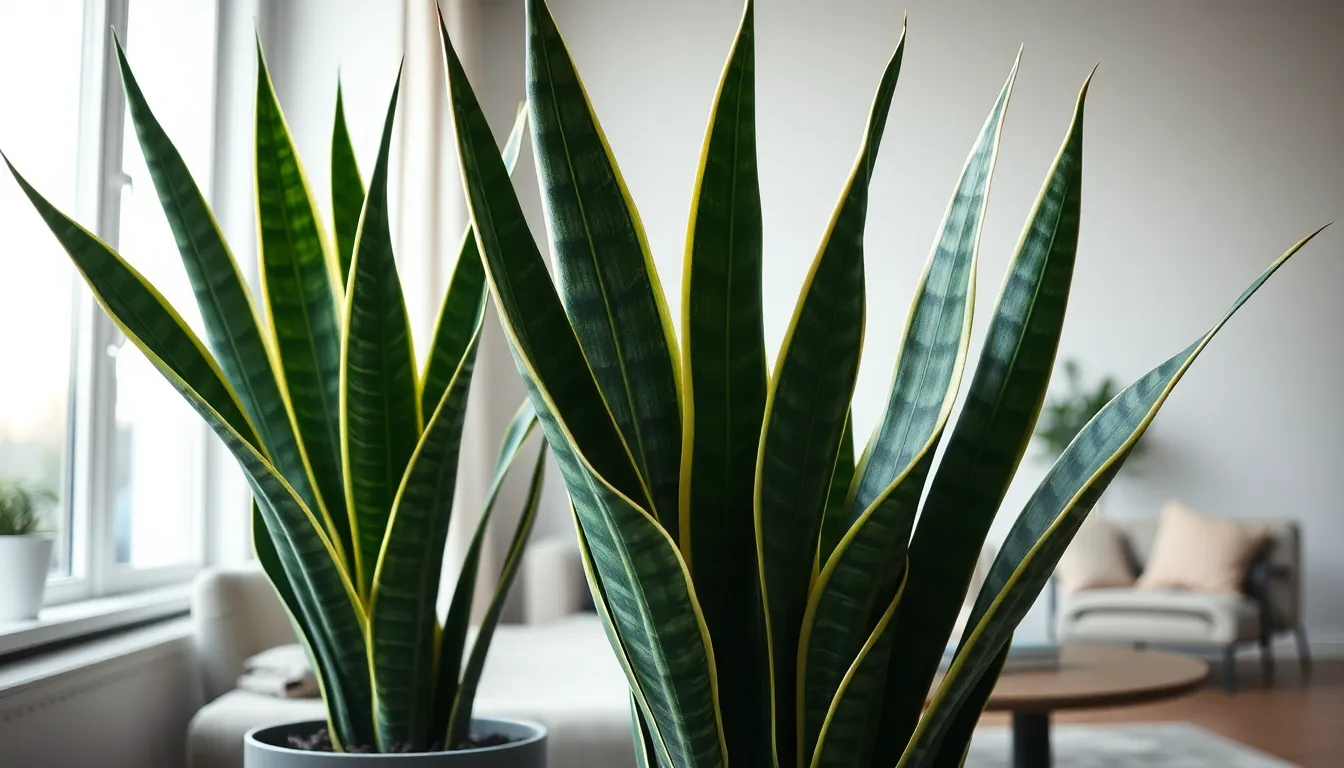
We’re excited to introduce you to one of the most striking snake plant varieties with its distinctive crossband patterns. Sansevieria zeylanica brings bold visual appeal to any space while maintaining the incredible resilience that makes snake plants so beloved.
Distinctive Dark Green Crossbands
Dark green base coloration with lighter green or silver horizontal stripes creates this variety’s signature look. These wavy crossbands run horizontally across each leaf, forming distinctive patterns that distinguish zeylanica from other snake plant types. We love how the contrasting bands add visual depth and texture to indoor displays without overwhelming smaller spaces.
Silver accents within the crossband patterns catch light beautifully, creating subtle shimmer effects throughout the day. The crossbands appear more pronounced on mature leaves, developing richer contrast as the plant establishes itself in your home.
Narrow Upright Leaves
Sword-like leaves grow in tight rosette formations, reaching heights of 3 to 4 feet in mature specimens. These narrow leaves maintain their upright stance without support, creating clean vertical lines that complement modern interior design. We appreciate how the pointed tips add architectural interest while the thick leaf structure provides impressive durability.
Growth patterns remain compact with leaves typically reaching 2 feet in width at full maturity. The upright habit makes zeylanica perfect for corner placements or narrow spaces where spreading varieties might overwhelm the area.
Hardy Drought-Resistant Features
Extreme drought tolerance allows this variety to thrive with minimal watering schedules, often going weeks between waterings. We’ve found that zeylanica handles neglect better than most houseplants, making it ideal for busy lifestyles or frequent travelers. The plant’s succulent nature stores water efficiently in its thick leaves.
| Hardiness Feature | Specification |
|---|---|
| Mature Height | 3-4 feet |
| Mature Width | 2 feet |
| Soil pH Range | 6-7 |
| USDA Zones | 9-11 |
Pest and disease resistance keeps maintenance requirements exceptionally low, while heat tolerance ensures consistent performance in various indoor temperatures. Well-drained soil with pH between 6 and 7 provides optimal growing conditions, though zeylanica adapts to various soil types. This Ceylon native thrives in partial shade conditions, making it perfect for areas with limited natural light access.
Sansevieria Moonshine (Silver Snake Plant)
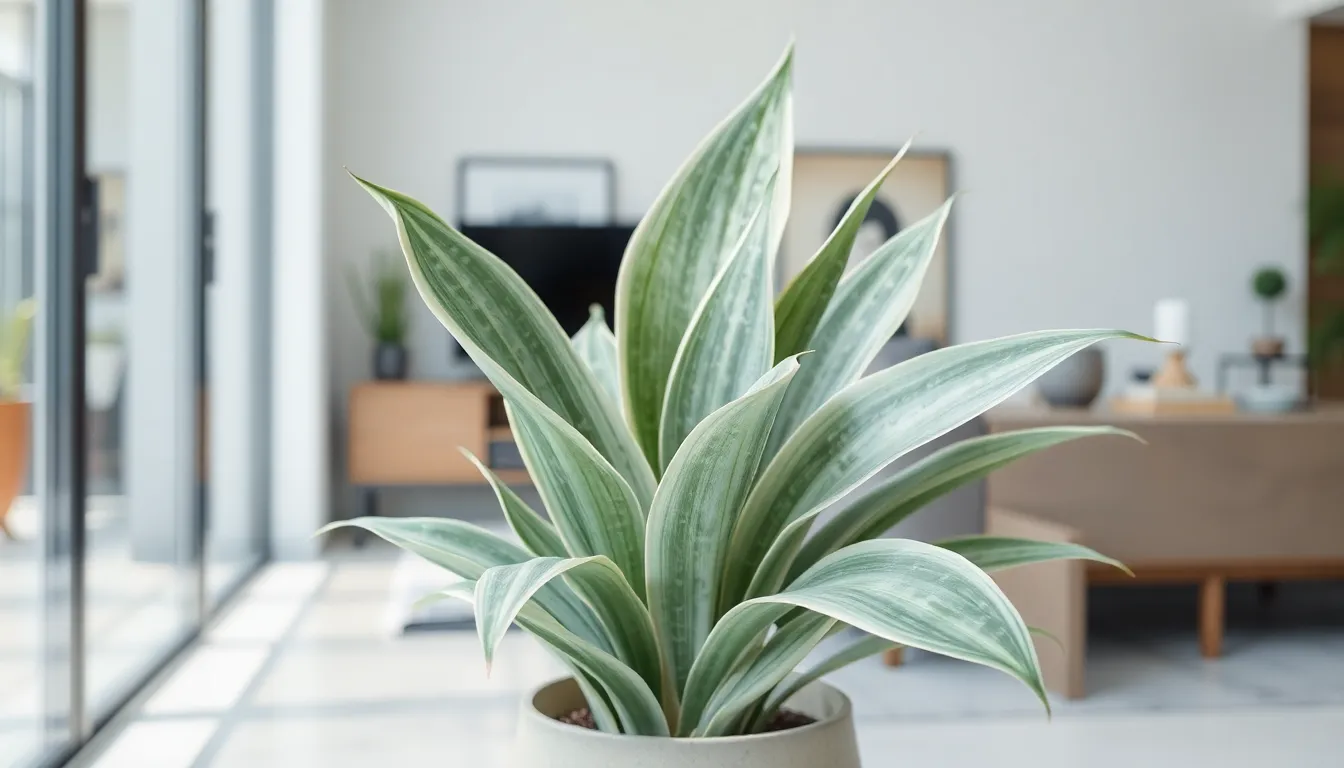
Sansevieria Moonshine stands out as one of the most visually distinctive snake plant varieties available to indoor gardeners. This stunning cultivar brings a soft, ethereal quality to any space with its unique silvery appearance.
Pale Silver-Green Coloration
Moonshine displays remarkably muted silver-green leaves that create a soft, dreamy appearance unlike any other snake plant variety. The pale coloration gives this plant an almost luminous quality that catches light beautifully in indoor settings. We notice how the silvery hue remains consistent throughout the growing season, maintaining its signature look year-round. These subtle tones make Moonshine an excellent choice for minimalist decor schemes and modern interiors where bold patterns might feel overwhelming.
Broad Flat Leaf Structure
Moonshine features distinctively broad, flat leaves that grow in an upright pattern from the plant’s base. The wide leaf structure creates a bold architectural statement while maintaining the classic snake plant silhouette we love. Each leaf develops with smooth edges and a substantial feel that adds visual weight to the plant’s overall appearance. We find that these broader leaves make Moonshine particularly effective as a statement piece in corners or as part of larger plant groupings.
Low Light Tolerance
Moonshine thrives exceptionally well in low light conditions, making it perfect for indoor environments with limited natural sunlight. This variety adapts beautifully to office spaces, bathrooms, and rooms with north-facing windows where other plants might struggle. We appreciate how Moonshine maintains its distinctive silver coloration even in dimmer conditions, unlike some plants that lose their unique characteristics without bright light. The plant’s ability to tolerate various lighting situations makes it one of the most versatile snake plant options for indoor cultivation.
Sansevieria Whale Fin (Masoniana)
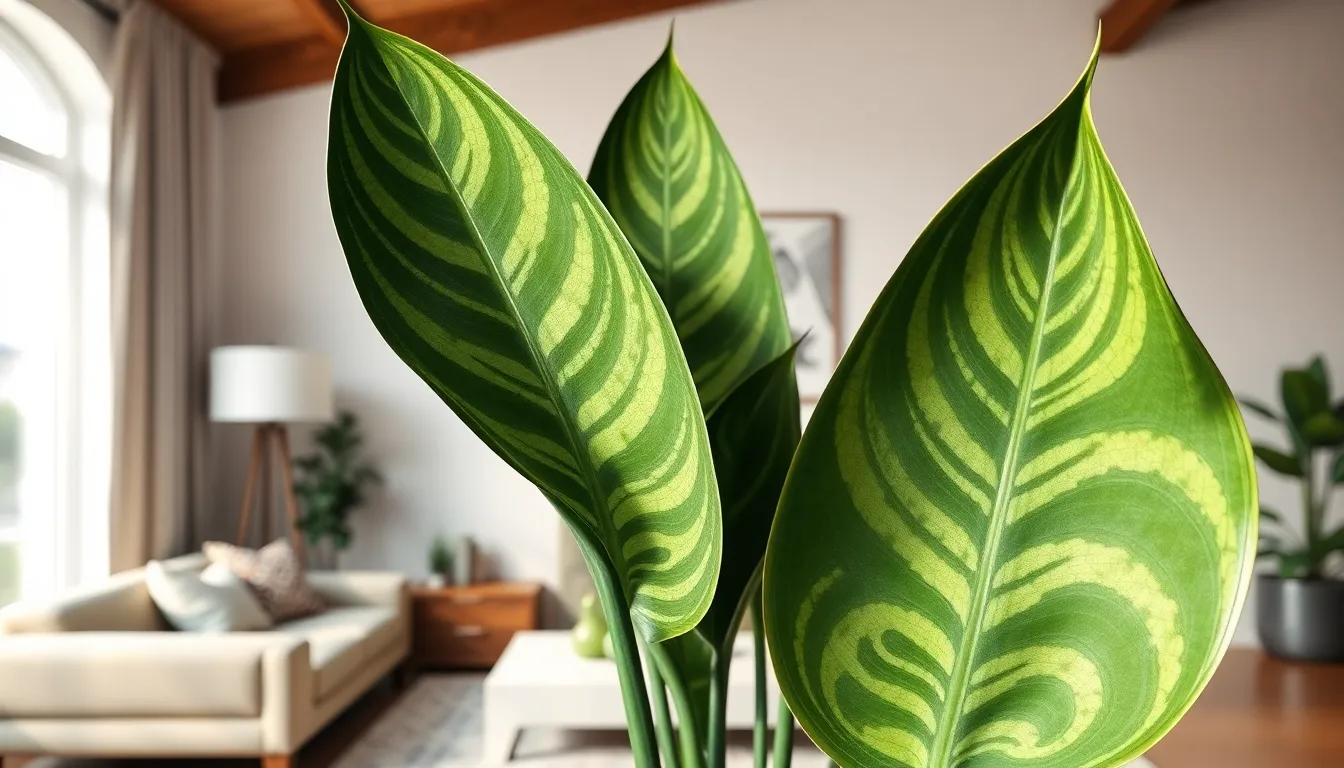
The Whale Fin Snake Plant stands out as one of the most distinctive varieties in the Sansevieria family. Scientifically known as Sansevieria masoniana, this remarkable plant features a unique growth pattern that sets it apart from all other snake plant varieties.
Single Large Paddle-Shaped Leaf
Featuring a dramatic single leaf design, the Whale Fin Snake Plant produces one large, paddle-shaped leaf that can reach impressive dimensions of 3 to 4 feet in length and 8 to 10 inches in width. This massive leaf displays thick, stiff, and waxy characteristics that give it substantial presence in any room.
Patterns of dark and light green spots create a mottled appearance across the leaf surface, resembling the fin of a whale and earning this plant its distinctive common name. The unique coloration and texture make each Whale Fin specimen visually striking and conversation-worthy.
Growing from a central rosette point, the leaf emerges either upright or slightly arching, creating an elegant silhouette that commands attention. This singular leaf structure makes the Whale Fin completely different from traditional multi-leafed snake plant varieties.
Dramatic Architectural Statement
Creating a bold focal point, the Whale Fin Snake Plant can grow up to 3 to 5 feet tall and 1 to 2 feet wide, making it an impressive architectural element for modern interiors. Its substantial size and unique form transform any space into a designer showcase.
Improving contemporary decor schemes, this plant’s exotic appearance works particularly well in minimalist settings where its dramatic silhouette can take center stage. The thick, paddle-shaped leaf acts as living sculpture, bringing natural beauty and geometric interest to indoor environments.
Positioning a mature Whale Fin Snake Plant creates instant visual impact, whether placed in entryways, living rooms, or office spaces. Its architectural presence rivals expensive decorative elements while providing the added benefits of air purification and natural ambiance.
Slow Growth Characteristics
Exhibiting slow growth patterns, the Whale Fin Snake Plant develops gradually over time, making it an excellent long-term investment for plant enthusiasts. This measured growth rate means you can enjoy its current size for extended periods without worrying about rapid changes or frequent repotting.
Maintaining its impressive appearance requires minimal intervention due to its drought-tolerant nature and resistance to overwatering issues. The plant thrives in well-draining soil and adapts well to various indoor conditions, from bright indirect light to lower light levels.
Benefiting beginners and experienced plant parents alike, this resilient variety tolerates neglect better than most houseplants while still rewarding proper care with healthy growth. Its low maintenance requirements and air-purifying qualities make it perfect for busy lifestyles or office environments.
Sansevieria Bantel’s Sensation
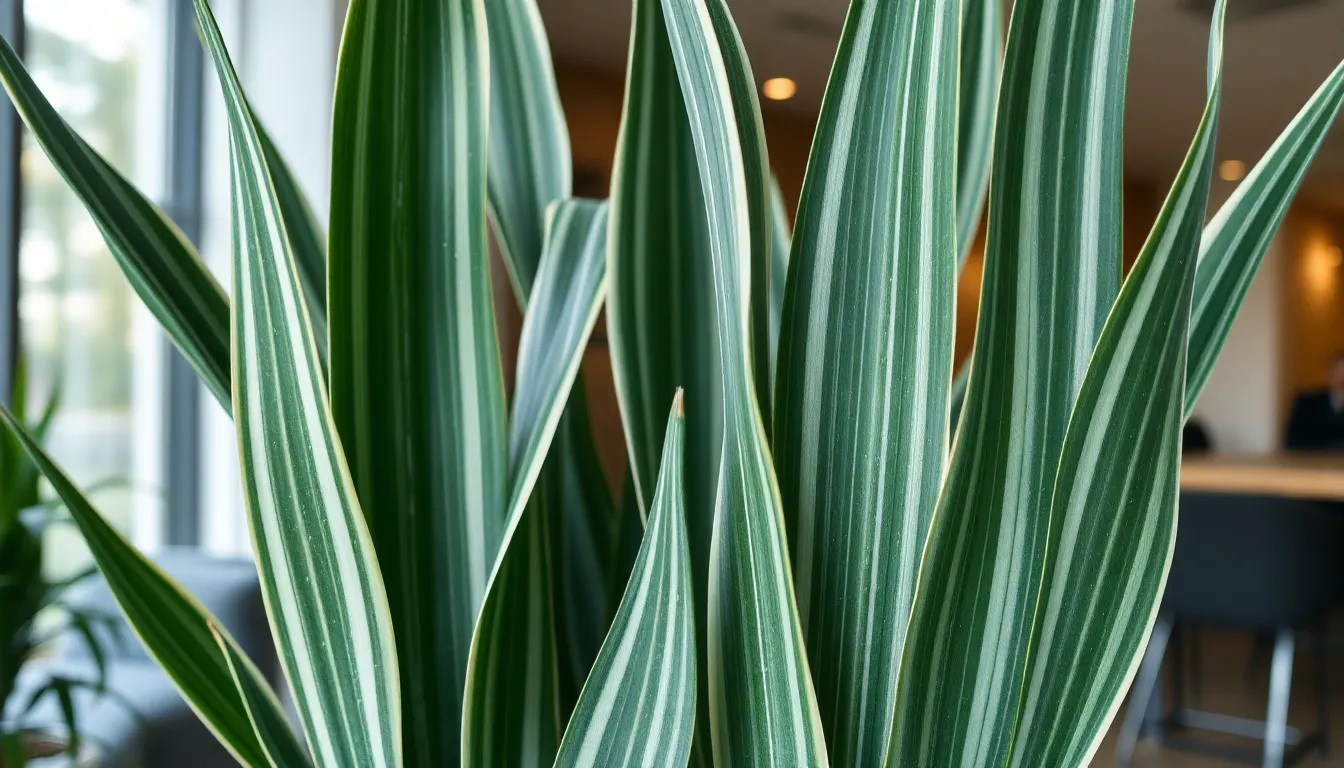
Sansevieria Bantel’s Sensation stands out as one of the most architecturally striking snake plant varieties we’ve encountered. This distinct cultivar transforms any space with its sculptural presence and rare variegation pattern.
White Vertical Striping Pattern
Vertical white stripes create the most distinctive feature of Bantel’s Sensation, setting it apart from other snake plants that typically display horizontal or mottled variegation. These creamy white stripes run the entire length of each leaf, contrasting beautifully against the dark grey-green foliage. Occasional ocher-cream and yellow markings add extra visual interest to this already stunning pattern.
Identifying Bantel’s Sensation becomes simple once you recognize these unique vertical stripes. Most snake plants feature crossbands or irregular patterns, but this variety maintains its straight-line variegation throughout the leaf’s growth. The consistent striping pattern makes it a coveted choice among collectors who appreciate rare plant characteristics.
Compact Growth Habit
Tall, slender leaves reach up to 3 feet in height while maintaining a narrow width of just 1.25 inches, creating an elegant vertical profile. These upright leaves grow in a rosette formation from a thick rhizome, producing a compact yet dramatic appearance. The architectural quality makes it perfect for modern interior spaces where clean lines matter.
Slow spreading characteristics allow Bantel’s Sensation to eventually form modest colonies up to 2 feet wide without overwhelming your space. This controlled growth pattern makes it ideal for container gardening and indoor cultivation. We particularly appreciate how it maintains its sculptural form while gradually expanding its presence.
Rare Variegated Features
Variegation stability in Bantel’s Sensation remains consistent throughout the plant’s life, unlike some varieties that may lose their patterns over time. The white striping maintains its intensity even in lower light conditions, ensuring your plant keeps its striking appearance year round. This reliability makes it a worthwhile investment for serious plant enthusiasts.
Drought tolerance combines with the plant’s variegated beauty, proving that stunning appearance doesn’t require high maintenance. Native to tropical western Africa, this variety inherits the hardy characteristics of its parent species while offering unique visual appeal. The plant thrives in various lighting conditions and resists common plant diseases like verticillium wilt.
Sansevieria Fernwood (Fernwood Punk)
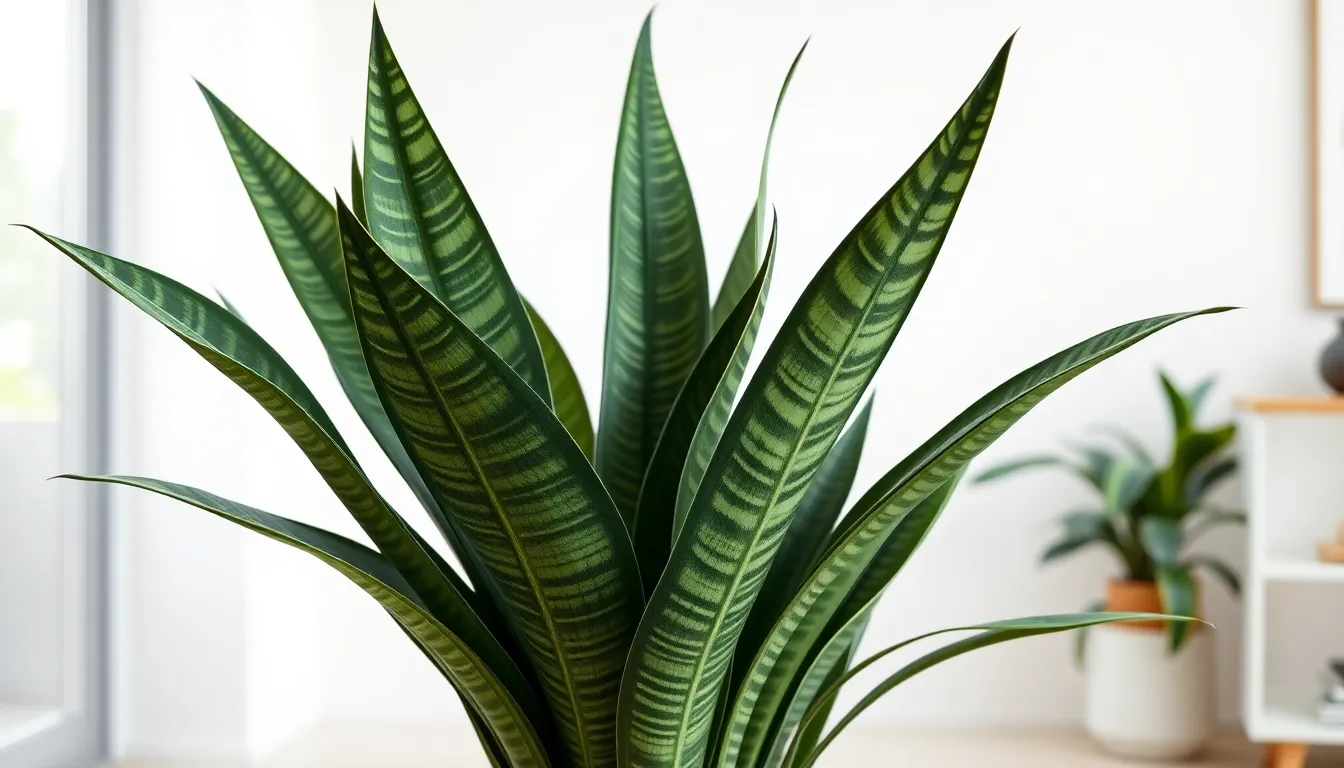
Sansevieria Fernwood stands out as one of the most architecturally striking snake plants with its distinctive punk inspired aesthetic. This unique variety combines the resilience we love in snake plants with a bold modern appearance that commands attention.
Narrow Cylindrical Leaves
Fernwood’s tubular leaves create a completely different visual profile compared to traditional flat snake plant varieties. These narrow cylindrical structures grow in dark green, almost black coloring that immediately catches the eye in any indoor space. Horizontal tiger print variegation patterns run across each leaf in lighter green tones, creating stunning contrast against the deep base color. The leaves maintain their cylindrical shape throughout their growth, reaching approximately 75 cm in height while staying remarkably narrow and pointed.
Upright Spiky Appearance
Multiple leaves cluster together to form a distinctive spiky formation that gives this plant its “punk” nickname. Each sharply pointed leaf grows straight upward in a tight clumping pattern, creating a bushy yet structured silhouette. The upright growth habit produces a compact form that spreads only about 30 cm wide, making efficient use of space while delivering maximum visual impact. These spiky clusters maintain their architectural integrity as the plant matures, with new growth emerging from the base to enhance the overall formation.
Modern Minimalist Appeal
Fernwood’s sleek cylindrical design perfectly complements contemporary interior aesthetics and minimalist decor schemes. The plant’s compact 75 cm height and 30 cm spread make it ideal for placement on shelves, desks, or as accent pieces in small living spaces. Its drought tolerant nature means it thrives with minimal care, surviving weeks without water while maintaining its striking appearance. The variety performs exceptionally well in low light and artificial lighting conditions, adapting seamlessly to modern offices, apartments, and homes where natural light may be limited.
Sansevieria Francisii (Spear Sansevieria)
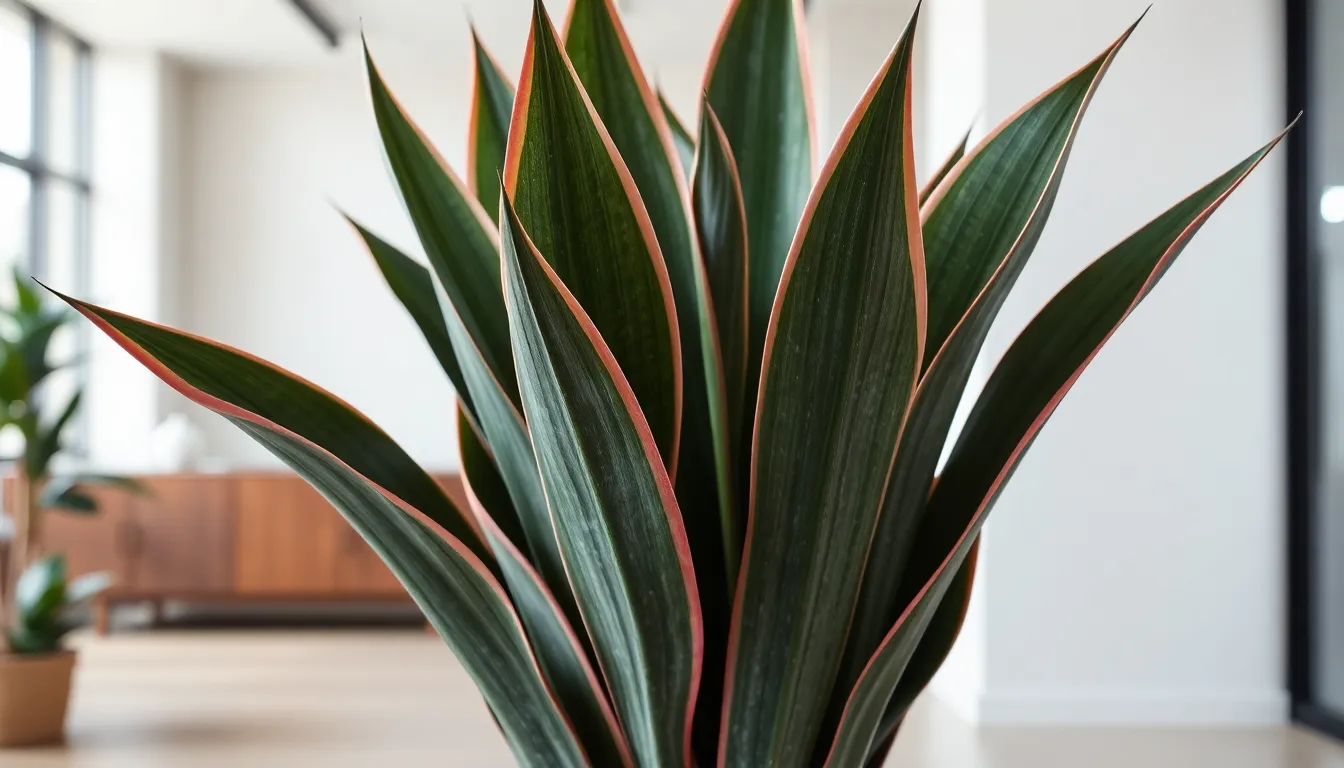
Sansevieria francisii represents a fascinating departure from the typical snake plant varieties we’ve explored. This distinctive species offers a compact, succulent-like appearance that makes it perfect for small spaces and unique arrangements.
Thick Succulent-Like Leaves
Spear-shaped leaves distinguish this variety from other snake plants with their remarkably thick, fleshy texture. The tubular leaves grow upright in tight rosettes, creating compact clusters that reach approximately 6 inches in height. These substantial leaves store water efficiently, giving them a plump, succulent appearance that differs dramatically from the flat, sword-like foliage of traditional snake plants.
Dark green cross-banding patterns create visual interest across the leaf surfaces, accompanied by subtle longitudinal lines that enhance the plant’s textural appeal. The leaves maintain their rigid, upright posture while displaying the characteristic stiffness that makes this species so architecturally appealing. Water retention capabilities within these thick leaves enable the plant to survive extended periods without irrigation.
Reddish-Brown Leaf Margins
Distinctive reddish-brown edges frame each leaf, creating a striking contrast against the dark green base coloration. This unique marginal coloring adds warmth and visual depth to the plant’s overall appearance. The borders maintain their rich hue consistently throughout the growing season, providing year-round aesthetic appeal.
Complementary color schemes work beautifully when pairing Sansevieria francisii with other desert plants or modern decor elements. These warm-toned margins help soften the plant’s architectural lines while maintaining its bold presence. Interior designers particularly appreciate how these reddish edges coordinate with earth-tone palettes and contemporary furnishings.
Desert-Adapted Characteristics
Native habitat conditions in Kenya have shaped this species into an exceptionally resilient houseplant that thrives in arid environments. The plant’s desert origins make it highly tolerant of neglect and perfect for busy households or office settings. Drought resistance capabilities exceed those of many traditional houseplants, requiring minimal watering schedules.
Compact growth habits make Sansevieria francisii ideal for terrariums, shelves, and small succulent arrangements where space is limited. The plant’s ability to thrive in dry conditions means it pairs well with other desert species in mixed plantings. Low maintenance requirements include tolerance for various lighting conditions and infrequent watering, making it suitable for both beginner and experienced plant enthusiasts.
Sansevieria Ehrenbergii (Blue Sansevieria)
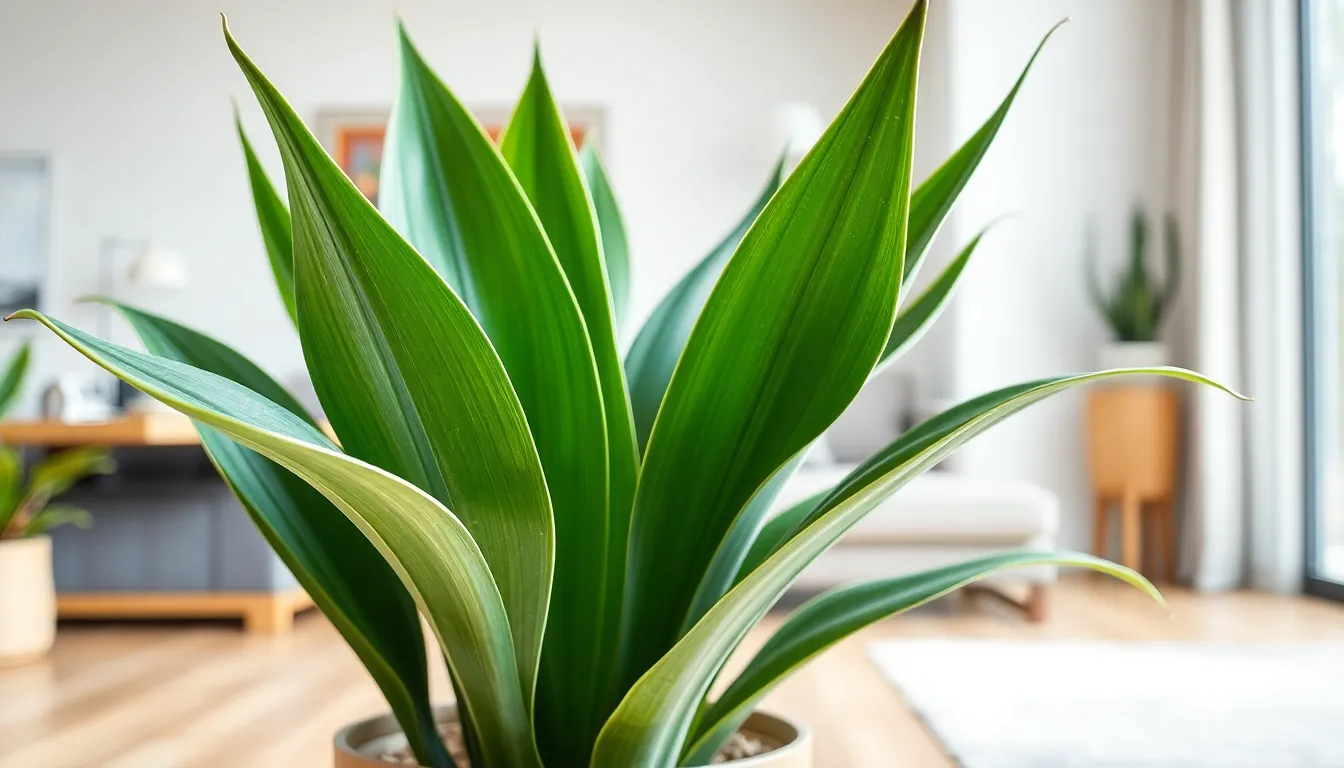
We encounter one of the most visually distinctive snake plant varieties in Sansevieria ehrenbergii, commonly known as Blue Sansevieria. This Ethiopian native stands apart from other snake plants with its remarkable blue-green coloration and uniquely curved leaf structure.
Blue-Green Leaf Coloration
Blue Sansevieria displays a stunning blue-green leaf coloration that creates a cooler, more ethereal appearance compared to traditional snake plants. These thick, fleshy leaves showcase deep blue-green tones that remain consistent throughout the plant’s life cycle. Unlike the typical bright greens found in other varieties, this species offers a sophisticated color palette that complements modern interior design schemes. Collectors particularly value this unique coloration because it adds visual depth and creates striking contrasts when paired with warmer-toned plants in indoor displays.
Boat-Shaped Leaf Structure
Distinctive boat-shaped leaves set Sansevieria ehrenbergii apart from the typical upright spear-like growth pattern seen in most snake plants. Each leaf features a prominent central groove running along its length, creating the characteristic curved, boat-like appearance that gives this variety its architectural appeal. Growing in an alternating stacked fashion, these sword-shaped leaves fan out in a V-shaped pattern rather than growing straight upward. Impressive lengths of 5 to 6 feet make this variety a dramatic focal point, while the curved structure adds sculptural interest that works beautifully in contemporary spaces.
Ethiopian Heritage Variety
Ethiopian origins make Sansevieria ehrenbergii a heritage variety with deep cultural roots in northeastern Africa’s diverse plant network. Native to Ethiopia’s unique climate conditions, this species has evolved exceptional drought tolerance and heat resistance that makes it incredibly hardy in various growing environments. Cultivation success comes from understanding its natural habitat preferences, including well-drained, rocky soils and sunny to mostly shaded conditions. Propagation works best through division of rhizomes and tubers rather than seed, maintaining the genetic integrity of this Ethiopian heritage plant while ensuring successful cultivation in home environments.
Sansevieria Kirkii (Star Sansevieria)
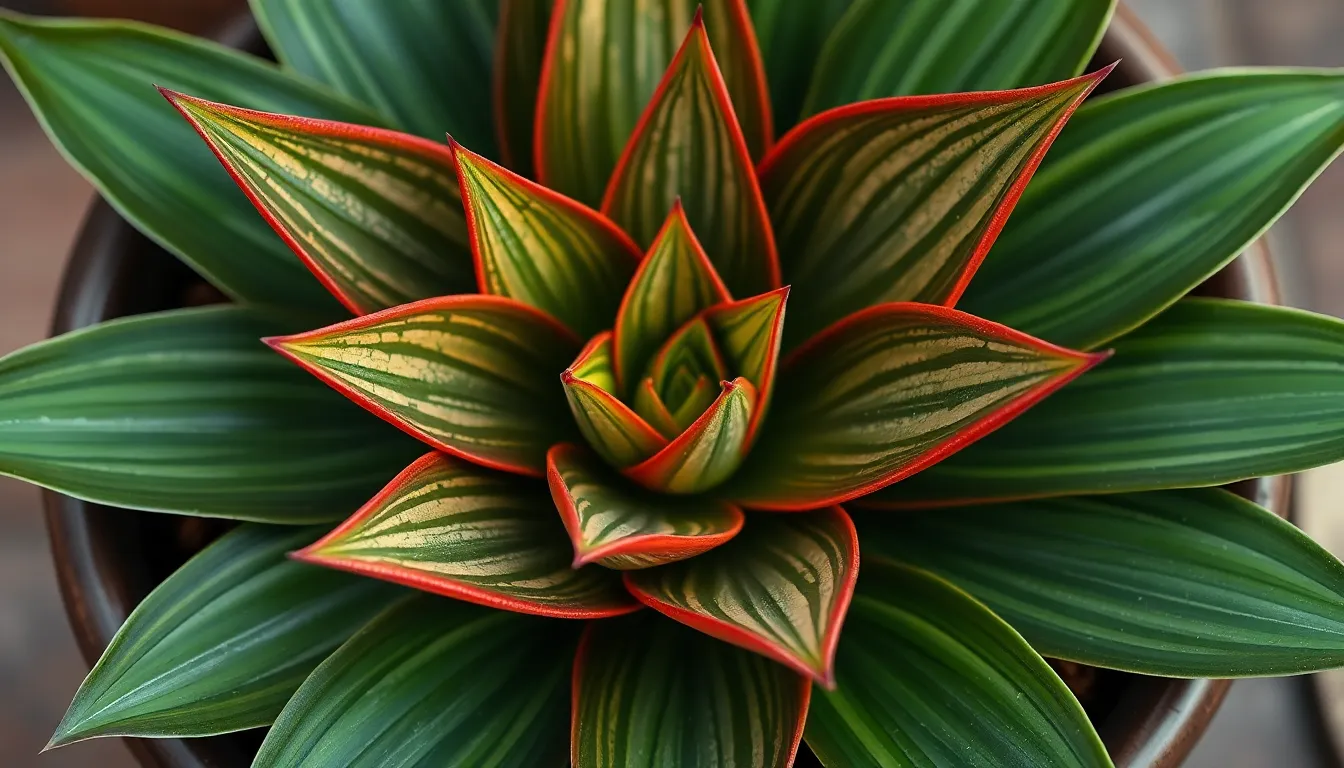
Sansevieria kirkii stands apart from traditional upright snake plant varieties with its unique horizontal growth pattern and distinctive star formation. This West African native brings sculptural beauty to indoor spaces through its ground hugging rosette structure.
Star-Shaped Rosette Formation
Kirkii creates stunning visual displays through its compact, star-shaped leaf arrangement that spreads horizontally rather than growing tall like most snake plants. The broad, sword-shaped leaves emerge from the center in a radiating pattern, forming an eye-catching starburst design that hugs the ground. Each leaf features wavy or scalloped edges that add sculptural dimension to the overall rosette formation.
We find this star pattern particularly striking in container arrangements where the full rosette can be appreciated from above. The leathery texture of each leaf enhances the architectural quality of the formation, creating depth and visual interest. This unique growth habit makes kirkii an excellent choice for tabletops, wide shallow planters, and areas where horizontal spread is preferred over vertical height.
Copper-Colored New Growth
New growth on Sansevieria kirkii displays beautiful copper tones that gradually mature into the plant’s characteristic green coloration with intricate mottled patterns. These copper hues appear most prominently on young leaves as they emerge from the center of the rosette, creating a warm contrast against the established foliage. The developing leaves showcase a blend of copper, silver, and gray tones before settling into their mature mid to dark green base color.
We observe that the copper coloration becomes more pronounced in brighter light conditions, though the plant maintains this attractive feature even in lower light environments. This color transition adds ever-changing visual appeal throughout the growing season as new leaves continuously emerge with fresh copper tints. The mottled patterns that develop include intricate combinations of green, silver, and gray that create complex, beautiful leaf surfaces.
Ground-Hugging Spread Pattern
Kirkii spreads horizontally through vigorous rhizomes while maintaining its low profile, typically staying close to the soil surface rather than reaching skyward. This spreading pattern allows the plant to form attractive colonies over time, creating natural ground cover in dry industry settings or filling container spaces with lush, architectural foliage. The rhizome system enables steady but manageable expansion, making it suitable for both container cultivation and outdoor xeriscaping applications.
We appreciate how this spread pattern differs significantly from other snake plant varieties, offering versatility in industry design and indoor arrangements. The slow but steady growth means the plant won’t quickly outgrow its designated space, while the spreading nature ensures fuller coverage over time. This growth habit makes kirkii particularly valuable for creating living carpets in succulent gardens or as an alternative to traditional upright snake plants in modern interior designs.
Conclusion
We’ve explored an incredible variety of snake plants that can transform any indoor space with their unique characteristics and architectural appeal. From the towering Whale Fin’s dramatic single leaf to the compact Star Sansevieria’s horizontal spread each variety brings something special to your plant collection.
The beauty of these plants lies not only in their diverse appearances but also in their shared resilience. Whether you’re drawn to the silvery elegance of Moonshine or the punk-inspired aesthetic of Fernwood these varieties all deliver the same low-maintenance benefits that make snake plants so beloved.
With options ranging from towering statement pieces to compact desk companions there’s truly a snake plant variety for every space and style preference. These remarkable plants prove that stunning visual impact doesn’t require complicated care routines.
Frequently Asked Questions
What makes snake plants ideal for modern homes and offices?
Snake plants are perfect for modern spaces due to their striking architectural appearance and extremely low maintenance requirements. They thrive in low light conditions, survive long periods without water, and provide air-purifying benefits. Their diverse shapes, sizes, and colors make them versatile design elements that complement contemporary decor while requiring minimal care.
Which snake plant variety is best for beginners?
Sansevieria trifasciata (Mother-in-Law’s Tongue) is ideal for beginners due to its exceptional resilience and upright growth pattern. The Golden Edge and Laurentii varieties are also excellent choices, as they maintain their vibrant appearance in low light and require infrequent watering, making them forgiving for new plant parents.
What is the most unique-looking snake plant variety?
Sansevieria Whale Fin (Masoniana) is the most distinctive variety, featuring a single dramatic paddle-shaped leaf that can grow 3-4 feet long and 8-10 inches wide. Its mottled dark and light green pattern resembles a whale’s fin, creating an architectural statement piece that serves as a bold focal point.
Which snake plant varieties are best for small spaces?
Silver Hahnii is perfect for small spaces with its compact rosette pattern and dwarf size. Sansevieria francisii (Spear Sansevieria) reaches only 6 inches in height, making it ideal for desks and shelves. The Skyline variety offers cylindrical appeal in a compact form suitable for tight spaces.
How often do snake plants need water?
Snake plants are extremely drought-tolerant and should be watered infrequently. Most varieties can survive weeks without water and prefer to dry out completely between waterings. Overwatering is more harmful than underwatering, making these plants perfect for busy lifestyles or forgetful plant owners.
Do snake plants really purify indoor air?
Yes, snake plants are recognized for their air-purifying capabilities. They remove toxins from indoor air and release oxygen, particularly at night, making them beneficial for bedrooms and office spaces. This natural air filtration adds health benefits to their aesthetic and low-maintenance appeal.
Which snake plant has the most dramatic height?
Sansevieria cylindrica (African Spear Plant) can reach 4-7 feet tall with straight cylindrical leaves, while Laurentii varieties grow 4-6 feet. Sansevieria ehrenbergii (Blue Sansevieria) also reaches impressive lengths of 5-6 feet, making these varieties ideal for creating dramatic vertical displays in larger spaces.
Can snake plants survive in rooms with no windows?
Most snake plant varieties thrive in low light conditions and can tolerate rooms with minimal natural light. Varieties like Moonshine and Golden Edge perform exceptionally well in dimmer settings while maintaining their unique coloration, making them suitable for interior offices and windowless spaces.

